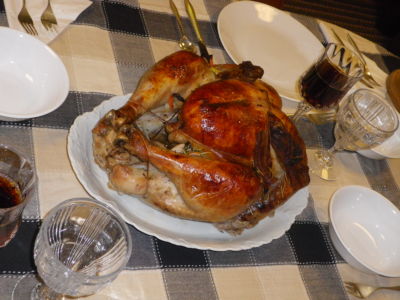I'm not bad at cooking and baking, so I perk up more at mysteries that feature food. Not so much the ones with cute, culinary titles and lots of recipes in them, though. I prefer books that integrate a lot of good food in the characters' lives and make me want to dash out to a restaurant or into the kitchen to put the pots and pans to work.
 |
| Crèpes Suzette |
 |
| Marseilles café |
When the moon hits your eye like a big pizza pie, that's not just amoré, it's a regular night in a book featuring Donna Leon's Inspector Brunetti, Andrea Camilleri's Inspector Montalbano or Michael Dibdin's Aurelio Zen. Maybe my favorite meal description is in Camilleri's The Smell of the Night, when Montalbano stops in at a tiny trattoria recommended to him. It doesn't look like much of a place to him, but he's ravenous and decides to give it a try. The proprietor tells him they have burning pirciati that evening if he feels up to it. Montalbano doesn't want to give the man the satisfaction of asking how the dish is prepared, and he certainly feels he's "up to it," whatever that means, so burning pirciati it is. When the dish arrives, it smells wonderful, and Montalbano immediately digs in––only to feel as if his mouth has burst into flames that are only barely subdued by his drowning them in an entire glass of wine.
 |
| Pirciati (not sure if it's burning, though!) |
 |
| Braised wild turkey |
 |
| Steak frites |
Pan-Seared Thick-Cut Strip Steaks (for four)
2 boneless strip steaks, 1-1/2 to 1-3/4 inches thick (about 1 pound each)
Kosher salt and ground black pepper
1 tablespoon vegetable oil
1. Adjust oven rack to middle position and heat oven to 275 degrees. Pat steaks dry with paper towels. Cut each steak in half vertically to create four 8-ounce steaks. Season steaks liberally with salt and pepper. Using hands, gently shape the steaks into uniform thickness. Place steaks on wire rack set in rimmed baking sheet; transfer baking sheet to oven. Cook until instant-read thermometer inserted horizontally into center of steaks registers 90-95 degrees for rare to medium-rare, 20-25 minutes; or 100-105 degrees for medium, 25-30 minutes.
2. Heat oil in 12-inch heavy-bottomed skillet over high heat until smoking. Place steaks in skillet and sear until well-browned and crusty, 1-1/2 to 2 minutes, lifting once halfway through to redistribute fat underneath each steak. Reduce heat if food begins to burn. Using tongs, turn steaks and cook until well-browned on the other side, 2 to 2-1/2 minutes. Transfer steaks to clean rack and reduce heat under pan to medium. Use tongs to stand two steaks on their sides. Holding steaks together, return to pan and hold them with the tongs so that you can sear all the edges until browned, about 1-1/2 minutes. Repeat with remaining 2 steaks.
3. Return steaks to wire rack and let rest, loosely tented with foil, for about 10 minutes. If desired, make a steak sauce in the now-empty skillet; e.g., red wine and mushroom pan sauce.
 |
| Delhi street food vendor |
 |
| Butter chicken over rice |
Butter Chicken from Amber India
Main ingredients
3 pounds chicken (2 half-breasts, 2 thighs, 2 legs), skinned
Juice of one lemon
1 tablespoon hot red pepper flakes
2 teaspoons salt
1-1/2 cups unflavored yogurt
2 tablespoons heavy cream
1-1/2 teaspoons garlic paste
1-1/2 teaspoons ginger paste
1/2 teaspoon ground coriander seed
1/2 teaspoon ground cumin
1/2 teaspoon garam masala
1/2 teaspoon salt
Sauce ingredients
1 teaspoon powdered ginger
1/2 teaspoon ground red chile
Pinch garam masala
Pinch mace
Pinch nutmeg
1/2 teaspoon ground white pepper
2 teaspoons brown sugar
1/4 cup butter
2 cups canned tomatoes, chopped
1 tablespoon tomato paste
2 cups water, or more as needed
2 tablespoons heavy cream
2 teaspoons ground fenugreek
Salt to taste
Instructions
1. Make 3 parallel cuts on top of each piece of chicken. Place the chicken in a resealable bag.
2. Combine the lemon juice, red pepper flakes and salt; pour over the chicken. Seal the bag and refrigerate 30 minutes.
3. Combine the yogurt and cream in a bowl; blend well.
4. Mix together the garlic paste, ginger paste, coriander, cumin, garam masala and salt. Add to the yogurt mixture, blending thoroughly.
5. When the chicken has marinated for 30 minutes, remove it from the refrigerator, open the bag and pour in the yogurt mixture. Reseal the bag and refrigerate overnight.
6. Next day, to make the sauce, combine the ginger, ground red chile, garam masala, mace, nutmeg, white pepper and brown sugar in a small bowl.
7. Melt the butter in a large skillet over medium-high heat. Add the tomatoes, tomato paste, the spice/sugar blend and water. Simmer, stirring frequently, for 20 minutes.
8. Add more water if the mixture gets too dry.
9. Preheat the oven to 450 degrees.
10. Remove the chicken from the marinade; discard the marinade.
11. Arrange the chicken pieces in a baking pan large enough to hold them in a single layer. Bake for 30 minutes.
12. Let the chicken cool until you can handle it; then remove the meat from the bones and discard the bones.
13. Add the chicken meat, the cream and fenugreek to the sauce. Simmer for 10 minutes, stirring frequently to prevent burning. Add salt to taste and serve over rice.
Serves four. Nutrition information per serving: 325 calories (not including the rice), 28 grams protein, 8 grams carbohydrates, 20 grams fat (10 grams saturated fat), 1 gram fiber.
 |
| Swedish cream wafers |
Swedish Cream Wafers
Wafer ingredients
1 cup salted butter (at room temperature, so it's soft)
1/3 cup thick cream
2 cups sifted flour
Granulated sugar for coating the wafers
Filling ingredients
1/4 cup salted butter (at room temperature, so it's soft)
3/4 cup sifted confectioner's sugar
1 egg yolk
1 teaspoon vanilla (or lemon extract if you prefer)
Instructions
Preheat the oven to 350 degrees.
Mix together the wafer ingredients and refrigerate the dough for at least an hour, until it is cold. Using one-third of the wafer dough at a time, keeping the rest cold, roll out the dough 1/8 of an inch thick on a lightly floured surface. Cut the dough with 1-1/2 inch round cookie cutter (flour the cutter so it doesn't stick), coat both sides of each wafer with granulated sugar, prick with a fork four times.
Bake the wafers for 7-9 minutes, until a light golden. Do not brown. Let cool.
While the wafers are baking and cooling, mix the filling ingredients until the filling is smooth. Once the wafers are completely cooled, spread the flat side of a wafer with the filling and lightly press the flat side of another wafer against the filling to make a filled cookie. Repeat with the rest of the wafers and filling.
Would you like to tell us some of your recipes and the books that inspire you to make them?

Enjoyed this post, Sister Mary. I do love Rex Stout's Nero Wolfe and Archie Goodwin and own the cookbook you mention. In the series book TOO MANY COOKS, Wolfe makes one of his rare excursions from his Manhattan brownstone. He and Archie travel by train to the Kanawha Spa in West Virginia, where a group of international chefs called Les Quinze Maîtres are meeting and cooking a special dinner. Wolfe will speak about the contributions of American cuisine to haute cuisine. He will also solve a murder that wasn't on the menu.
ReplyDeleteDo you have a favorite recipe from TOO MANY COOKS? I looked at the index online and it was mouth-watering.
ReplyDeleteSister Mary, it's so hot here right now I'm stewing in my own juices. I need some of Nero Wolfe's Pineapple Sherbert, Rex. Preferably accompanied by small macaroons.
ReplyDelete
ReplyDeleteOh, Sister, everything looks so delicious!
I have to try the Swedish Cream Wafers. Apparently what they lack in food that's appealing they make up in sweets.
The food described in Nordic books is sometimes more vile than the crimes.
Susie
Susie, I totally agree. Those Nordics have served us some good crime books and great sweets. Making Spritz cookies is always on my Christmas calendar.
ReplyDeleteYour recipes and books you mention are irresistible, Sister. I'm going to make that pasta for dinner and read that Camilleri for dessert.
Susie, those Swedish Cream Wafers are too good, especially for a butter fiend like me.
ReplyDeleteDella, you'll have to let us know if smoke comes out of your nostrils if you make burning pirciati!